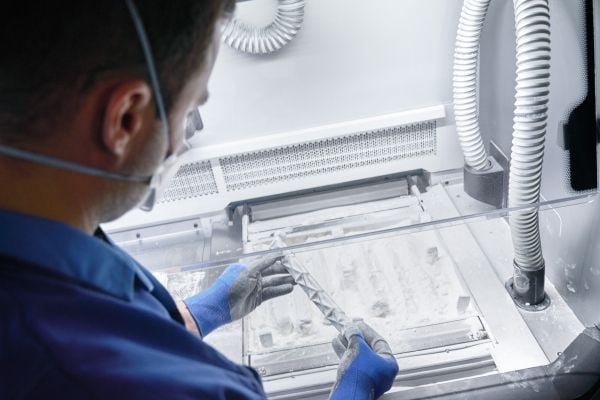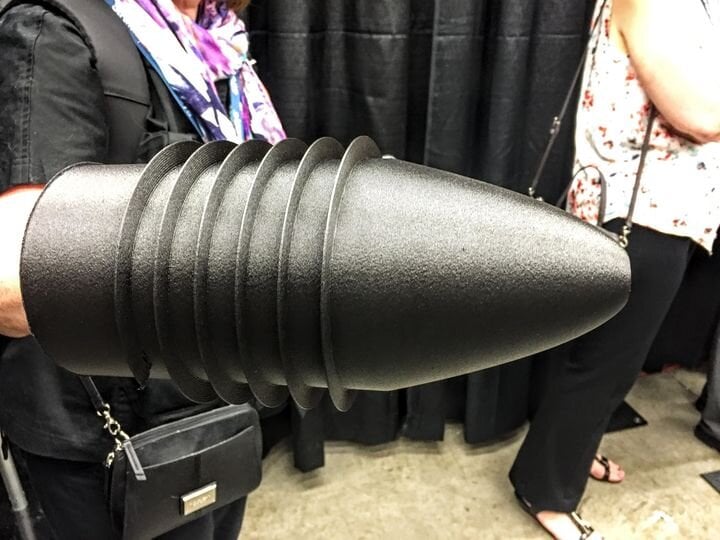![[Image: BMW Group]](https://fabbaloo.com/wp-content/uploads/2020/05/P90329562_lowRes_3d-printed-window-gu_img_5eb097eb2620b.jpg)
There isn’t an industry on Earth that won’t be touched, and potentially transformed, by the maturation of 3D printing technology. But for this to happen, additive manufacturing has to migrate from the hobbyist’s desktop to factory floors all across the world.
If we follow the money — more on that a little later — we see this revolution is already well underway. In the meantime, it’s worth diving into just what industrial-scale 3D printing looks like, how it works and why it holds so much promise for so many of our most important industries.
What Are the Goals of Industrial 3D Printing?
We all know what a desktop 3D printer looks like and roughly what it’s capable of. The concept of industrial 3D printing takes that promise and scales it up to where manufacturers can better meet ongoing demands for large quantities of goods — but that’s just the beginning. As Alan Amling from UPS enthusiastically explained back in 2016, industrial 3D printing represents more than a larger-scale printing apparatus: it’s the inception of something called the “manufacturing cloud.”
The manufacturing cloud offers this compelling vision for the future of on-demand fabrication:
-
Instead of investing in manufacturing facilities and equipment, companies of all sizes can tap into “manufacturing as a service” (MaaS).
-
MaaS gives companies the ability to operate with far less inventory on hand at any given time.
-
Traditional manufacturing is focused on creating (for example) batches of 100 products. As needed, MaaS turns that 100-piece order into 10 orders of 10 units, with each batch receiving different customization options, features or variations.
Traditional manufacturing centered on mass producing large quantities of identical parts. It meant companies ran the risk of misjudging demand and then getting saddled with unsold merchandise that’s difficult to move.
It’s also not a secret that society as a whole is shifting to “on-demand” everything. Industrial 3D printing greatly reduces the distance between manufacturer and end user.
What Makes Industrial 3D Printing So Impressive?
Industrial 3D printers, compared with desktop printer models, greatly improve on the accuracy of manufactured parts and products. One reason is because machines intended for industrial deployments calibrate themselves before each printing run begins. Desktop 3D printers are comparatively much more fickle and require a lot more on-demand calibration from machinists. A byproduct of the “set and forget” nature of an industrial 3D printer is that it can turn out much larger batches with far greater consistency and repeatability.
Another reason accuracy gets a boost in industrial 3D printing applications is that these printers use a heated production chamber to fight the effects of warping — a common occurrence in desktop 3D printer models thanks to the superheated material (usually plastic) cooling rapidly as production wraps up.
Dual extrusion is another impressive feature of industrial 3D printers. This involves the application of a water-soluble material that acts as a support mechanism for in-progress prints. Adding this support material means industrial 3D printers can be used to make more complex and demanding parts than previous-generation desktop machines.
This is one concept that’s easier to visualize with the help of examples — so let’s dive into the many industries poised to benefit from this bona-fide revolution in “how stuff gets made.”
Automobile Manufacturing, Architecture, Defense and Beyond
The automotive industry relies on rapid prototyping to design and test car and truck parts for safety and durability. Individual 3D printers make one-off prototypes easier and faster to build. But what about mass-producing automobiles using industrial-scale 3D printers?
Delphia Automotive, Ford and BMW have all thrown their hats in the ring to begin exploring the production of “end parts” through 3D printing. But even before that concept takes off in earnest, we should expect industrial 3D printing to make it easier to create customized vehicles and limited-run editions.
Let’s plot this journey even further out into the future: In a world where cars drive themselves, individual automotive customers will be able to log onto an automaker’s website, specify which components of their new ride they’d like customized, and then sit back while a 3D printer-equipped factory floor builds the car and readies it for the road. From there, the car departs the manufacturing facility on its own and drives itself to the customer’s home.
Industrial-scale 3D printing is also likely to transform architecture as we understand it. We’ve already seen some of the exciting ways civil engineers and architects can use printers to build bridges quickly and sustainably. Sometime in 2019, Amsterdam will become the home of the world’s first successfully installed 3D printed bridge using steel.
The future could be even more exciting. One of the chief benefits of industrial 3D printing is the ability to produce larger components. In this case, those components include structural components in buildings. The Dubai “office of the future” provides a sneak peek at what a concrete-based, modular building design could look like. Communal spaces aren’t the only kind of structure 3D printing applies to, either. Affordable housing is a crisis even in many developed nations, which makes the promise of mass-producing concrete homes an attractive concept indeed.
Even the defense industries are looking to capitalize on increasingly capable industrial-scale additive manufacturing. This is a field that’s continually exploring new ways to produce high-performance materials affordably. In an age of uncertain geopolitics and a wide assortment of global threats, it’s no surprise that the U.S. Department of Energy is, as we speak, exploring how to 3D print military equipment from plastics reinforced with carbon fiber, while the U.S. Army is exploring 3D printing in its supply chain.
Where Does Industrial-Scale 3D Printing Go From Here?
In 2015, global spending on industrial 3D printing topped out at $
11 billion. In 2019, forecasts indicate spending could rise to $27 billion. GE and other global corporations know this technology represents the future of most major industries on Earth, which is likely why GE has spent billions on 3D printing companies. They anticipate many billions of dollars more in savings once they successfully incorporate this technology into their production facilities. As industrial 3D printing takes off, expect that number to rise dramatically — and for 3D printing to become even more of a mainstream concept than it already is.











